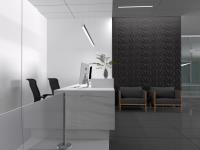 Add My Company
Add My Company
Sign In

Sound Zero has been blogging about ways to control office acoustics and how it can contribute to a productive workforce.
There’s nothing worse than getting home at the end of the working day feeling as though you haven’t achieved what you set out to do.
There could be a number of reasons for this. Perhaps something unexpected cropped up. Or the system was down. Maybe someone was off sick and suddenly, you had to rearrange your day.
You can be forgiven for the instances that are out of your control. What makes you a true professional is how well you adapt to these situations.
But what happens when the noise of your office distracts you? The conversation from the marketing department; the sound of the telephone constantly ringing; the general acoustics of your office.
A twenty-minute task takes an hour, and before you know it, you haven’t achieved nearly as much as:
1. You set out to do.
2. You’re capable of.
Imagine if this predicament was shared amongst everyone in your office. Without realising, the noise and acoustics of your office may have contributed to a less-productive, less-successful workforce. In the end, it’s your profits and your business that suffers.
The science of sound
Before we explore some of the more economical and practical ways to control office acoustics, it’s worth understanding where noise comes from and how it travels.
This, in turn, may provide you with an insight into how to manage unwanted nosie and control your office acoustics.
When a sound is created, it propagates from the source in all directions, radiating outwards until it encounters a boundary element.
There are three different points that intersect when sound reacts with its environment that all contribute to what we hear:
1. Direct sound. This implies that the sound has not reacted with its environment before it reaches your ears (which is what we want).
2. Reflected sound. We hear reflected sound when the noise interacts with a surface that sends the sound bouncing back. This reflected sound can be incredibly obstructive when combined with the direct sound we mentioned as it causes the brain to work harder in decoding the two similar sounds to localise its source (which is how humans can tell which direction a sound is coming from). This mental conflict contributes to fatigue and a loss of concentration.
3. Reverberation. This is how long it takes for sound energy to dissipate in a space until it is inaudible. Your brain can cope with singular sources of reverberation as it helps us know how big a space is, but when your brain tries to unravel multiple reverberated signals all at once, it can struggle to create a clear sonic image of the environment, again causing tiredness and in some cases claustrophobic responses.
Excess noise levels causes mental conflict and contributes to fatigue and a loss of concentration”
When a sound wave encounters a surface, it is either absorbed or reflected. An example of an absorbent material is carpet.
Sounds will reflect off hard, shiny surfaces such as windows, desks and hard floors. The reflected sound wave will continue to travel until it reflects off another surface.
The sound you hear in a room is an accumulation of direct sound and all the sound waves being reflected off many different surfaces.
The key point to consider here is: how many hard, shiny surfaces are there in your office? The chances are quite a lot.
We understand that it would be both impractical and unrealistic to sacrifice all your hard, shiny surfaces. There are, however, cost-effective strategies you can employ to control the noise of your open-plan office.
Top ten cost-effective ways to control office acoustics and manage unwanted noise
1. Careful arrangement of teams.
Hot-desking may well be en voguefor the fluid, modern office, but different departments work in different ways. For example, the marketing team benefits heavily from regular communication and collaboration, whereas the accounts team will need to have a more focused approach to their work.
Through careful consideration, you’ll be able to arrange departments based on the nature of their daily activities.
2. Dedicated meeting rooms/quiet areas.
Whilst we’re aware of the benefits of the open-plan environment, offices need to consider the times when it is necessary and appropriate to hold quiet meetings in a private setting.
With that in mind, we recommend that you consider a room divider. These can be cheaply made from plywood and clad in an acoustically absorbent material, such as our pyramid profile acoustic foam or our recycled CorkBee panels. These effective little barriers are lightweight and modular so they can be moved around to suit a dynamic work environment.
3. Separate spaces for lunch breaks.
With the chaos and unpredictable nature of certain job roles, it may be necessary to eat lunch and take breaks at your desk.
Whilst we advocate frequent breaks and rest periods, doing so at one’s desk could lead to unwelcome noise and conversation. This could greatly affect productivity amongst your team.
To combat this, we recommend you encourage staff to take breaks away from their desks.
4. Plants.
Whilst providing an aesthetic appeal, plants do a great job at absorbing sound. Consider introducing some greenery into your office to help with bad office acoustics, as well as bring a calming sense to your team.
5. Acoustically treat ceilings.
Let’s face it, carpets in offices just seem rather outdated, but did you know they are a good sound absorber and aid noise control?
Ceilings, along with floors, account for a large portion of office space and they are often the easiest place to apply acoustic treatment . Not only that but they never need a vacuum.
The addition of acoustic foam to line the ceilings directly above noisy areas makes for a dramatic improvement in noise reduction and can actually add a point of interest in the room.
6. Separate rooms for noisy machinery.
Machine and server rooms are an integral part of most modern businesses. These devices are large and typically emit noise that will simply travel straight through the stud walls found in your typical office.
To stop the sound from transmitting into the workspace, line the storage rooms with Sound-Zero Class ‘0’ insulation. This acoustic insulation has been developed with industry in mind. It is fire rated to the highest standard to keep expensive and vital machinery safe and sound.
7. Sound-absorbing materials.
As previously discussed, hard surfaces aren’t great at absorbing sound. Where possible, opt for softer floor solutions (such as carpets) to help control unwanted noise.
Additionally, strategically placed acoustic panels help to deaden unwanted sound. An experienced acoustician will provide you with a detailed summary and make suggestions on where to place sound-absorbent materials that will work to your advantage.
8. Lining underneath the desks.
Desks account for around 40% of the flat surfaces in an office and we can use this space to our advantage, by acoustically treating the un-used space on the underside of the them.
This does not detract from a rooms’ design or hinder workflow, in fact, most of the staff won’t even notice the addition of acoustic foam right under their noses. Ridged or pyramid foam is perfect for this application, it’s easy to cut and place in awkward spaces and has an excellent noise reduction rating.
9. Playing ambient noise.
Research suggests that noise itself isn’t distracting. Unwanted noise is what’s causing the distracted and unproductive environment that may be affecting your workforce.
By playing low-level, ambient sound, it can mask the unwanted noise, making conversations for listeners that aren’t intended to hear them unintelligible, and therefore much easier to ignore.
10. Make partitions an office feature.
Wall partitions don’t just have to be used as a way of separating areas or concealing noisy equipment.
A stylish and contemporary wall partition makes for an incredibly appealing feature wall. Choose a partition wall that offers some form of acoustic absorption whilst offering an element of simple style and tasteful minimalism.
For more information on Cost-effective ways to control office acoustics talk to Sound Zero
Enquire Now
List your company on FindTheNeedle.
